Mfsd2a regulates the blood-labyrinth-barrier formation and function through tight junctions and transcytosis
Abstract
The Blood-Labyrinth Barrier (BLB) is pivotal for the maintenance of lymphatic homeostasis within the inner ear, yet the intricacies of its development and function are inadequately understood. The present investigation delves into the contribution of the Mfsd2a molecule, integral to the structural and functional integrity of the Blood-Brain Barrier (BBB), to the ontogeny and sustenance of the BLB. Our empirical findings delineate that the maturation of the BLB in murine models is not realized until approximately two weeks post-birth, with preceding stages characterized by notable permeability. Transcriptomic analysis elucidates a marked augmentation in Mfsd2a expression within the lateral wall of the cochlea in specimens exhibiting an intact BLB. Moreover, both in vitro and in vivo assays substantiate that a diminution in Mfsd2a expression detrimentally impacts BLB permeability and structural integrity, principally via the attenuation of tight junction protein expression and the enhancement of endothelial cell transcytosis. These insights underscore the indispensable role of Mfsd2a in ensuring BLB integrity and propose it as a viable target for therapeutic interventions aimed at the amelioration of hearing loss.


 求助内容:
求助内容: 应助结果提醒方式:
应助结果提醒方式:


